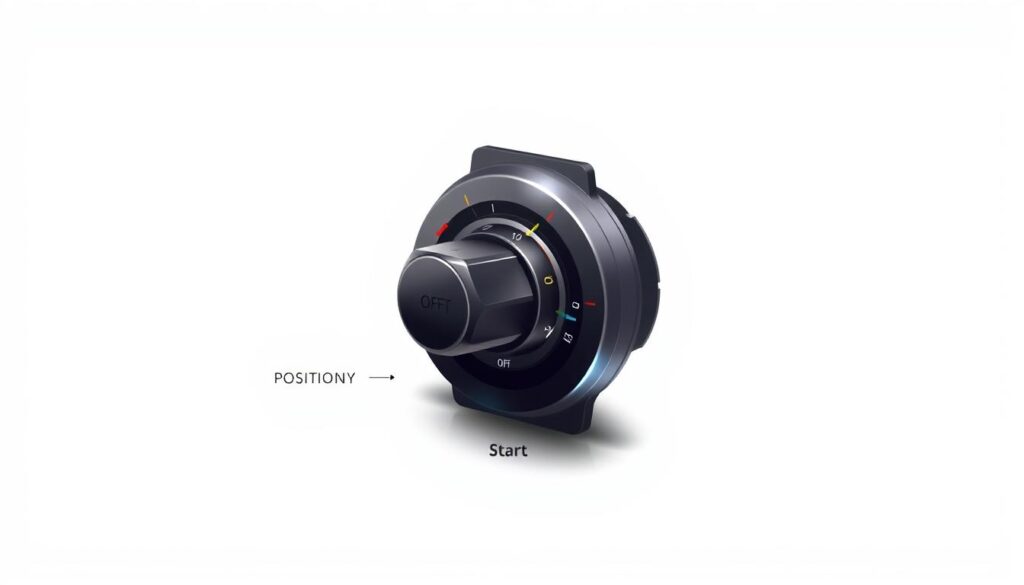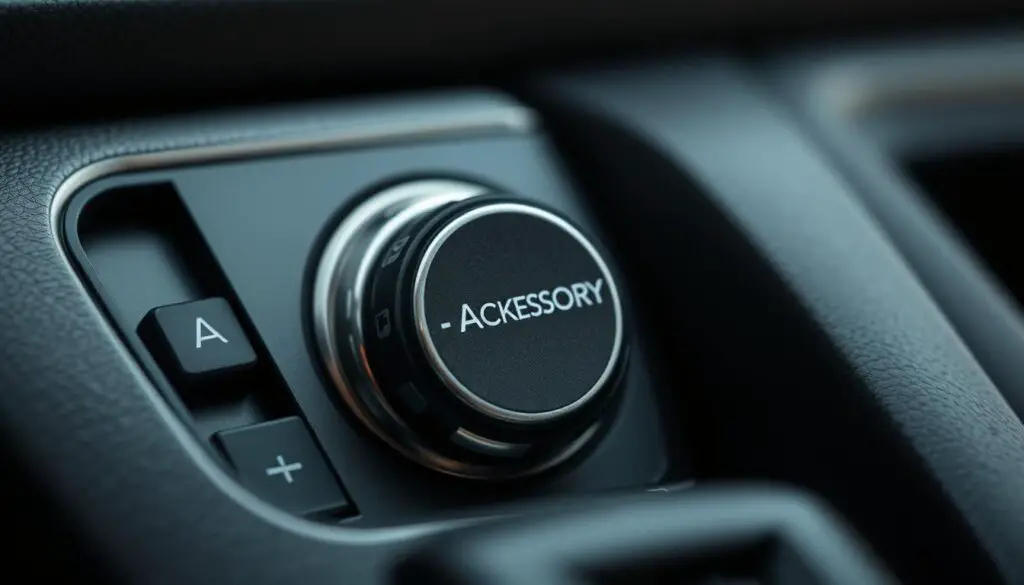Modern vehicles come equipped with various features that enhance the driving experience. One such feature is the accessory mode, which is activated by adjusting the ignition switch to accessory mode. This mode allows vehicle owners to power certain electrical components without starting the engine.
The car accessory mode is designed to provide convenience and flexibility. It enables users to use features like the radio, lights, and other accessories without the engine running, which can be particularly useful in various situations.
Understanding the functionality and benefits of accessory mode is essential for vehicle owners. This article will delve into the details of ignition switch to accessory mode, exploring its significance and relevance to modern vehicles.
Key Takeaways
- Accessory mode allows powering electrical components without starting the engine.
- It provides convenience and flexibility for vehicle owners.
- Understanding accessory mode is essential for maximizing its benefits.
- The feature is useful in various situations, such as camping or working in the vehicle.
- Proper use of accessory mode can help prevent battery drain.
Understanding the Ignition Switch Positions
Understanding the different positions of the ignition switch is essential for drivers to utilize their vehicle’s features effectively. The ignition switch controls various vehicle functions, and knowing its positions can help drivers manage their vehicle’s systems efficiently.
The Four Common Ignition Positions Explained
Most vehicles have four common ignition positions: Lock, Accessory, On, and Start. The Lock position is where the steering wheel is locked, and the key can be removed. The Accessory position allows the use of certain electrical systems without starting the engine. The On position powers all electrical systems, and the Start position is used to start the engine.
The Role of the Accessory Position in Modern Vehicles
The Accessory position is particularly useful as it enables drivers to use features like the radio, power windows, and charging ports without running the engine. This position is convenient for situations where the driver needs to access certain vehicle functions without starting the car, such as when camping or waiting in the vehicle. The list of features available in Accessory mode includes:
- Audio system
- Power windows
- Charging ports

What Happens When You Turn the Ignition Switch to Accessory
The ignition switch’s accessory position is designed to power certain vehicle systems without engaging the engine. When you turn the ignition switch to accessory mode, you’re essentially preparing your vehicle’s electrical systems for use.

Electrical Systems That Activate
In accessory mode, several electrical systems become active. These include the vehicle’s audio system, allowing you to listen to music or the radio without the engine running. Power windows and sunroofs also become operational, making it convenient to adjust them without starting the engine. Additionally, accessory outlets and USB ports are powered, enabling you to charge your devices.
Other systems that may activate in accessory mode include the vehicle’s climate control systems, although this can vary depending on the vehicle’s make and model. Some vehicles may also allow the use of certain driver assistance features or interior lighting in accessory mode.
Systems That Remain Inactive
While accessory mode activates several electrical systems, many critical vehicle functions remain inactive. The engine, for instance, does not start in accessory mode. Headlights and other exterior lighting typically require the ignition to be in a different position, often the “on” position, to function. Additionally, safety features like airbags and certain driver assistance systems are generally inactive in accessory mode.
It’s also worth noting that prolonged use of accessory mode can drain the vehicle’s battery if the engine is not running to recharge it. Therefore, it’s advisable to use accessory mode judiciously.
Step-by-Step Guide to Accessing Accessory Mode
Accessing accessory mode in your vehicle can be a straightforward process if you know the right steps. The method may vary depending on whether your vehicle has a traditional key ignition or a push-button start system.
In Traditional Key Ignition Vehicles
For vehicles with traditional key ignition, follow these steps:
- Insert the key into the ignition switch.
- Turn the key to the “Accessory” or “ACC” position. This is usually the first click when turning the key clockwise.
- You will know you’re in accessory mode when the dashboard lights up, and accessories like the radio turn on.
In Push-Button Start Vehicles
For push-button start vehicles, the process is slightly different:
- Make sure the key fob is inside the vehicle.
- Press the engine start/stop button once without pressing the brake pedal. This will typically put the vehicle in accessory mode.
- The vehicle’s accessories should now be operational.
Confirming You’re in Accessory Mode
To confirm you’re in accessory mode, check that the vehicle’s accessories are working:
| Accessory | Expected Behavior in Accessory Mode |
|---|---|
| Radio | Turns on and functions normally |
| Power Windows | Operational |
| Dashboard Lights | Illuminated |
By following these steps, you can easily access and confirm accessory mode in your vehicle, whether it’s equipped with a traditional key ignition or a push-button start system.
Key Vehicle Functions Available in Accessory Mode
Accessory mode in vehicles allows drivers to access various electrical systems without starting the engine. This feature is particularly useful for providing comfort and convenience without the need for the vehicle to be in motion or for the engine to be running.
Audio System Operation
The audio system is one of the primary functions that remain operational in accessory mode. Drivers can enjoy listening to music, podcasts, or audiobooks without the engine running, which is convenient during long stops or when camping.
Key audio features available in accessory mode typically include:
- Radio playback
- Bluetooth connectivity for streaming devices
- AUX input for external devices
Power Windows and Sunroof Functionality
In addition to the audio system, power windows and sunroofs often remain functional in accessory mode. This allows drivers and passengers to adjust their windows or sunroof for ventilation or to let in natural light.
It’s worth noting that some vehicles may have settings that allow you to configure how long these features remain active after the ignition is turned off.
Charging Ports and Accessory Outlets
Accessory mode also enables the use of charging ports and accessory outlets within the vehicle. This is particularly useful for charging electronic devices such as smartphones, tablets, or laptops.
Drivers can keep their devices powered while on the go or during extended stops, making accessory mode a practical feature for both everyday driving and long road trips.
When to Use the Accessory Position
Knowing when to use the accessory mode can be incredibly useful in various situations. The accessory position on your ignition switch allows you to power certain vehicle features without starting the engine. This can be particularly handy in scenarios where you need to use your car’s systems without driving.
Practical Scenarios for Everyday Drivers
For everyday drivers, the accessory mode is useful when you need to charge devices or listen to music without running the engine. For instance, if you’re camping and need to charge your phone or listen to music, you can use the accessory mode. It’s also convenient when you’re waiting for someone and want to keep the radio on without idling the engine.
Professional and Emergency Uses
In professional or emergency contexts, the accessory mode can be invaluable. For example, tow truck operators or roadside assistance personnel may need to use equipment like winches or lights without driving the vehicle. Similarly, in emergency situations, first responders might use the accessory mode to power medical equipment or communication devices.
By understanding when to use the accessory position, you can maximize its benefits while avoiding potential drawbacks like battery drain.
Safety Considerations When Using Accessory Mode
While accessory mode offers flexibility, there are important safety considerations to keep in mind to avoid potential risks. Using accessory mode can be convenient for various purposes, such as listening to music or charging devices without starting the engine. However, it’s crucial to be aware of the potential downsides.
Battery Drain Concerns
One of the primary concerns with using accessory mode is battery drain. If the engine is not running, using accessories like the radio, lights, or charging ports can quickly deplete the battery. To avoid this, it’s recommended to limit the use of high-drain accessories when the engine is off. For more information on managing battery health, you can refer to resources that discuss retained accessory power and its implications.
Security Implications
Another safety consideration is the security of your vehicle when in accessory mode. Leaving your vehicle in accessory mode for extended periods, especially in unattended or unsafe locations, can increase the risk of theft or vandalism. Ensure that your vehicle is locked and that you are aware of your surroundings.
Safety Features That May Be Disabled
Some safety features may be disabled or not function fully when the vehicle is in accessory mode. For instance, certain advanced driver-assistance systems (ADAS) may not be operational. It’s essential to understand which safety features are affected and plan accordingly.
| Safety Feature | Status in Accessory Mode |
|---|---|
| Advanced Driver-Assistance Systems (ADAS) | Disabled |
| Airbag System | Operational |
| Anti-lock Braking System (ABS) | Disabled |
Troubleshooting Common Accessory Mode Issues
Troubleshooting accessory mode problems requires a systematic approach to identify and fix the issue. Accessory mode issues can manifest in various ways, such as accessories not powering on, a stuck ignition switch, or battery drain. Understanding these problems is crucial for effective troubleshooting.
When Accessories Won’t Power On
If accessories won’t power on when in accessory mode, it could be due to a blown fuse, faulty wiring, or a malfunctioning ignition switch. Check the fuse box for any blown fuses related to the accessory mode. Inspect the wiring for any signs of damage or wear. If the issue persists, it may be necessary to consult a professional mechanic.
Stuck Ignition Switch Problems
A stuck ignition switch can prevent the vehicle from entering or exiting accessory mode. If the ignition switch is stuck, try gently jiggling the key or, in the case of push-button start vehicles, check for any debris or issues with the start button. If the problem continues, it may require replacement.
Battery-Related Complications
Battery drain is a common issue when using accessory mode, especially if the vehicle is not started for an extended period. To mitigate this, ensure that all accessories are turned off when not in use.
Preventing Battery Drain
To prevent battery drain, limit the use of accessory mode when the engine is not running. Regularly check the battery’s condition and charge level.
Jump-Starting After Accessory Mode Drain
If the battery has drained due to prolonged use of accessory mode, jump-starting the vehicle may be necessary. Ensure you follow proper jump-starting procedures to avoid damage to the electrical system.
By systematically addressing these common issues, you can troubleshoot and often resolve problems related to accessory mode. Regular maintenance and awareness of the vehicle’s systems can help prevent many of these issues.
Conclusion
Turning the ignition switch to accessory mode is a common practice for many drivers, allowing them to use various car features without starting the engine. As discussed, this mode activates several electrical systems, including the audio system, power windows, and charging ports.
Using the car accessory mode responsibly is crucial to avoid battery drain and ensure safety. By understanding when to use the accessory position, drivers can enhance their overall driving experience and maintain their vehicle’s health.
In conclusion, being aware of the ignition switch to accessory mode and its functions can significantly impact how you interact with your vehicle. By leveraging this knowledge, you can make the most of your car’s features while maintaining safety and efficiency.
FAQ
What is the accessory mode in a vehicle?
The accessory mode is a position on the ignition switch that allows certain electrical systems to operate without starting the engine.
How do I access accessory mode in my vehicle?
To access accessory mode, you typically need to turn the ignition switch to the “ACC” or “Accessory” position. In push-button start vehicles, you may need to press the button once or twice without pressing the brake pedal.
What systems are typically active in accessory mode?
In accessory mode, systems such as the audio system, power windows, sunroof, and charging ports are usually active.
Can I use accessory mode to charge my devices?
Yes, accessory mode typically allows you to use the vehicle’s charging ports and accessory outlets to charge your devices.
How long can I leave my vehicle in accessory mode?
It’s generally recommended to avoid leaving your vehicle in accessory mode for extended periods, as it can drain the battery.
What are the risks of using accessory mode excessively?
Excessive use of accessory mode can lead to battery drain, which may cause starting issues or other electrical system problems.
Can I use accessory mode while the engine is running?
Yes, you can use accessory mode while the engine is running, but it’s not necessary, as the electrical systems are already operational.
How do I know if my vehicle is in accessory mode?
Check your vehicle’s dashboard or instrument cluster for indicators, such as lights or messages, that confirm accessory mode is active.
Can I troubleshoot accessory mode issues on my own?
Yes, you can troubleshoot common accessory mode issues, such as checking fuses, ensuring proper ignition switch operation, and consulting your owner’s manual.
What should I do if my vehicle’s accessory mode is not working?
Consult your owner’s manual or contact a dealership or mechanic for assistance in diagnosing and resolving the issue.


